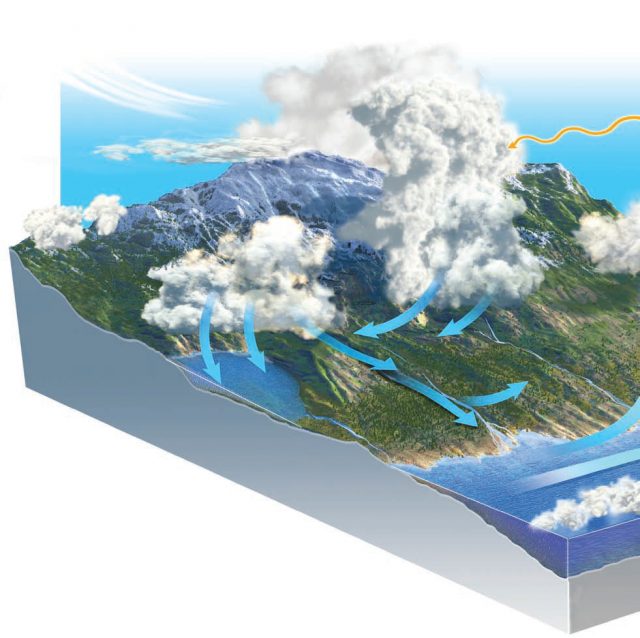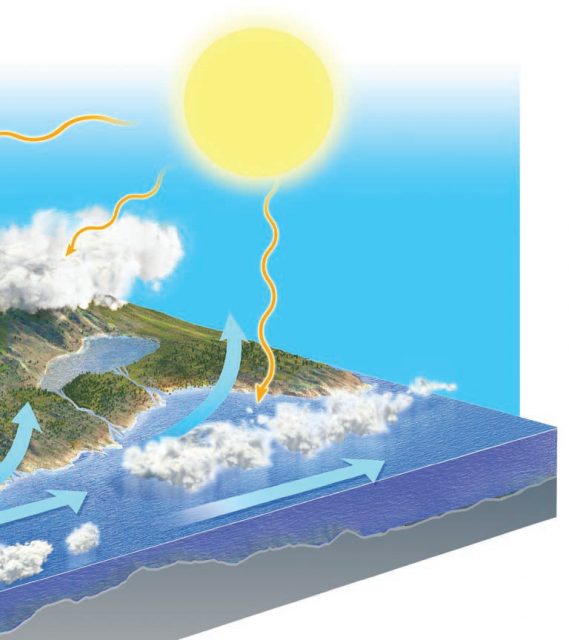Atmospheric Moisture
MOISTURE IN THE ATMOSPHERE, in the form of water vapor, liquid water, and ice, controls most aspects of our weather and climate. Moisture moves back and forth from Earth's surface to the atmosphere and, once in the atmosphere, is transferred vertically and laterally by moving air. Atmospheric moisture is expressed as clouds, precipitation, storms, weather fronts, and other phenomena. In this chapter, we explore how and where moisture occurs in the atmosphere, what happens when moisture moves with air currents, and how such motions are expressed as clouds, precipitation, and other aspects of weather.
Examine this figure and observe the various features. Try to identify which features involve water in one form or another. Next, consider how moisture can move from one place to another, and from one state of matter (gas, liquid, solid) to another. After you have done this for each main feature shown, read the text surrounding the figure.

Our world has various types of clouds, some of which are shown here in the large figure and the photograph above. Some clouds are thin and wispy, whereas others are tall and puffy. Some are high in the troposphere, while others are close to Earth's surface. Some clouds are associated with precipitation (rain, snow, hail, or sleet), but most are not.


What is in a cloud, how do we classify and name different types of clouds, and what do different types of clouds tell us about what is going on in the atmosphere?
Most clouds and precipitation are caused by cooling of moist air. Such cooling generally occurs when air rises into cooler parts of the atmosphere. Cooling of moist air can also occur when warmer air interacts with cooler land or water. As moist air cools, water vapor can change into a liquid (water drops) through the process of condensation. If cold enough, water vapor can instead form ice crystals through the process of deposition. Also, water drops and ice crystals can form from one another. In any case, the water drops and ice crystals are what forms clouds and, under the right conditions, cause various types of precipitation.

For each place where a cloud is shown in the large figure, what are some possible reasons why the air might be cooling at that location?
The amount of moisture in the atmosphere varies laterally from place to place and vertically between different heights in the atmosphere. We commonly use the term humidity to express how much moisture is in the atmosphere.
In this figure, predict which areas would have more humidity compared to other areas. How would this extra humidity be observed in the atmosphere, how would the air feel to you, and how would increased humidity affect your weather?
Water moves from the surface to the atmosphere through the process of evaporation, where liquid water becomes water vapor. Most evaporation occurs over the oceans, but significant amounts also occur over lakes, streams, and other surface water. Water also gets into the atmosphere from moisture released by moist soil and by plants through their leaves to the atmosphere, a process called transpiration. The combination of plant transpiration and evaporation from Earth's surface is evapotranspiration. The released water vapor is invisible but can condense into visible mists.

On the large figure, examine the surface, both the water and land, and identify places where moisture could move from the surface to the atmosphere.
Expressions of Moisture
The large figure on these two pages shows a wide variety of ways that moisture is expressed on the surface and in the atmosphere. Water is easily identifiable in the large body of water (ocean) on the right, in the two lakes on land, and in the streams. This water is shown in liquid form, but under cold-enough circumstances there could also be ice, such as if the lakes were at least partially frozen or if the ocean had some sea ice (frozen seawater) or icebergs (large floating chunks of ice). We can easily recognize water in its solid form (ice) in the snow on the high mountains. There would also be a zone of especially moist air (more water vapor) over and adjacent to the ocean, lakes, streams, and wet parts of the land, but we cannot see it because water vapor is not visible.
Even less obvious is the water contained in the green plants and the underlying soil. This moisture moves from these sites to and from the atmosphere, such as rain that falls from the clouds, soaks into the soil, and is taken up by plants, which can release this moisture back into the atmosphere via transpiration.
Moisture in the atmosphere is expressed in the various types of clouds. Most clouds are visible to us because they contain tiny drops of liquid water — even if there is no rain associated with the cloud. The wispy, higher-level clouds consist of ice crystals, which are easily blown and streaked out by the strong upper-level winds. The higher parts of some of the taller lower-level clouds would also contain ice, which can remain aloft or eventually accumulate into such large particles that it falls to the surface as snowflakes or hail. In all, many aspects of our planet owe their existence to moisture in the atmosphere and to the exchange of moisture between the atmosphere and the surface.